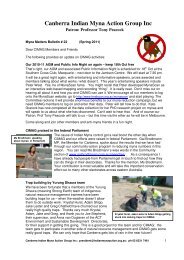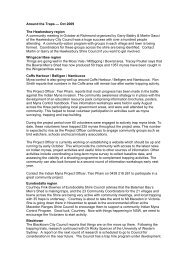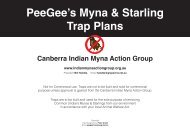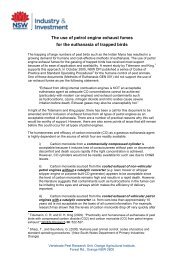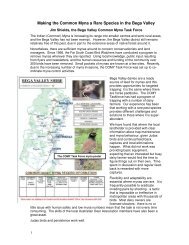download as a PDF, 52Kb - Canberra Indian Myna Action Group Inc.
download as a PDF, 52Kb - Canberra Indian Myna Action Group Inc.
download as a PDF, 52Kb - Canberra Indian Myna Action Group Inc.
Create successful ePaper yourself
Turn your PDF publications into a flip-book with our unique Google optimized e-Paper software.
<strong>Canberra</strong> <strong>Indian</strong> <strong>Myna</strong> <strong>Action</strong> <strong>Group</strong> <strong>Inc</strong><br />
Patron: Prof Tony Peacock<br />
President’s 2010-11 Report<br />
It is my ple<strong>as</strong>ure to present the 2010-11 President’s Report for the<br />
<strong>Canberra</strong> <strong>Indian</strong> <strong>Myna</strong> <strong>Action</strong> <strong>Group</strong> <strong>Inc</strong> (CIMAG).<br />
This p<strong>as</strong>t year h<strong>as</strong> been a steady year for CIMAG.<br />
I would like to first recognize the work of the CIMAG Committee: Bruce Lindenmayer, Peter Franklin,<br />
Anne I’ons, Greg Flowers, Rosemary Blemings, Marg Peachey, Alison Russell-French, Peter Ormay<br />
and Megan van der Velde for their work on behalf of the group over the p<strong>as</strong>t year. I also wish to<br />
record our appreciation for the support and work of our Patron, Prof Tony Peacock. I must also<br />
acknowledge Graham Gliddon for the many hours of work he continues to do each month in collating<br />
the capture data, and David Cook for maintaining the CIMAG website and chatlines.<br />
The achievements of the <strong>Group</strong> in tackling <strong>Indian</strong> Myn<strong>as</strong> in our region are due to the efforts of<br />
CIMAG members. It is their efforts in spreading the word about the threat posed to our wildlife by<br />
myn<strong>as</strong> and in trapping which have been the re<strong>as</strong>on for our collective success. So a big thankyou to<br />
all our members.<br />
2010-11 can again be regarded <strong>as</strong> a successful year. But it h<strong>as</strong> not been a year in which we<br />
have made major strides in the <strong>Canberra</strong> region because of some difficulties that we will need to<br />
work on in the current year. While things have been steady here, the anti-myna program more<br />
widely h<strong>as</strong> been highly successful. Many new groups were formed and there w<strong>as</strong> much more<br />
interest by Victorians and Queenslanders in doing something about myn<strong>as</strong>. Also, 2010-11 saw<br />
the launch of <strong>Myna</strong>Scan by Peter West of the Inv<strong>as</strong>ive Animals Collaborative Research Centre,<br />
and Peter Bird of SA Biosecurity Dept continued the campaign to stop Victorian myn<strong>as</strong> moving<br />
westward into South Australia. The local councils and communities that have set up control<br />
activities reported good <strong>Indian</strong> Myn<strong>as</strong> capture numbers.<br />
A number of activities of the p<strong>as</strong>t year are worth specifically mentioning.<br />
We continued the public education and awareness raising effort during 2010-11. CIMAG does<br />
this in a number of ways:<br />
• through interviews and media coverage - here we need to thank Tony Peacock for mentioning<br />
us in his Feral Hour with Alex Sloane on ABC 666, and Merylyn Condon in her 2CA Gardening<br />
Gurus gardening program. The item on the local ABC TV Stateline Program earlier this year<br />
had multiple runs on ABC 24 and raised the profile of the myna-control program across<br />
Australia: this brought many requests for information and traps from people interstate.<br />
• presentations to community groups and at conferences. Foremost amongst these were<br />
presentations to the 15 th Australian Vertebrate Pest Conference, to the NSW CWA<br />
Agricultural/Environmental Conference and the Ballarat <strong>Myna</strong> Control Workshop. As well, we<br />
also gave presentations to community groups in <strong>Canberra</strong> and at the launch of the Wollongong<br />
program.<br />
• through brochures and pamphlets. These were well-received. The photo sheet of “<strong>Canberra</strong>’s<br />
Native Backyard Birds and the Introduced Pest Birds” have been a particular winner, and is a<br />
great education tool for children to learn about our native birds and what we are seeking to<br />
protect.<br />
• Through the CIMAG website (www.indianmynaaction.org.au). For the first time we have p<strong>as</strong>sed<br />
¼ million website hits – some 239,390 hits with some 20,259 unique visitors.<br />
<strong>Canberra</strong> <strong>Indian</strong> <strong>Myna</strong> <strong>Action</strong> <strong>Group</strong> <strong>Inc</strong>: c/- 6 Fanning Place KAMBAH ACT 2902: ph 02 6231 7461
<strong>Canberra</strong> <strong>Indian</strong> <strong>Myna</strong> <strong>Action</strong> <strong>Group</strong> <strong>Inc</strong><br />
Patron: Prof Tony Peacock<br />
Providing support for myna control activities elsewhere h<strong>as</strong> taken up a lot of time over the<br />
p<strong>as</strong>t year. Our success h<strong>as</strong> been an inspiration to other groups and individuals across NSW and<br />
to a lesser extent Victoria and Queensland. While this is good to see, it does mean that we field a<br />
lot of phone calls and emails from people interstate on how they can manage myn<strong>as</strong> in their area.<br />
The trapping effort continues across <strong>Canberra</strong> and our district. There are a couple of <strong>as</strong>pects<br />
worth mentioning:<br />
• over the p<strong>as</strong>t year capture rates slowed: we put this down to trappers having removed most of<br />
the naïve, e<strong>as</strong>ily trappable myn<strong>as</strong> in their are<strong>as</strong>, leaving the wary; the slow provision of new<br />
traps in new are<strong>as</strong> – new traps in new are<strong>as</strong> always produce high capture levels for a period;<br />
and the lack of myn<strong>as</strong> – this l<strong>as</strong>t one is not a bad thing.<br />
• <strong>as</strong> at June 2011, Graham Gliddon had records of 37,719 myn<strong>as</strong> removed since CIMAG started<br />
with 5,500 removed in 2010-11. A reminder to trappers to respond to Graham’s monthly<br />
request for capture info – even if it is a zero – to enable us to keep re<strong>as</strong>onably accurate<br />
statistics.<br />
• a disappointment h<strong>as</strong> been the slowdown in trap building at the Alexander Maconochie Centre.<br />
This h<strong>as</strong> meant that we have not be able to provide local people with traps in a timely manner.<br />
As such the waiting list grows – now over 150 people – and the time to provide a trap to people<br />
on the list is quite some months. Moreover the plans for the gaol to make flat-pack versions of<br />
the PeeGees trap for interstate people h<strong>as</strong> not <strong>as</strong> yet resulted in any being made up. We will<br />
take these matters up with the authorities in an endeavor to re-invigorate what h<strong>as</strong> been an<br />
excellent partnership between CIMAG, the ACT Government and the Alexander Maconochie<br />
Centre.<br />
We supported good science and research through our <strong>as</strong>sistance to Kate Grarock for her PhD<br />
research project on myn<strong>as</strong>. Her project will provide some valuable insights into the efficacy of our<br />
myna control activities. Thanks to all those skilled bird observers who helped Kate by doing bird<br />
surveys over the three years. The five non-trapping control suburbs that were part of her project –<br />
Red Hill, Chapman, O’Connor, Campbell and Bonython – are now open for trapping. We are<br />
giving people who want traps in those suburbs priority to try to reduce the growth in myna<br />
populations that occurred there and in the adjacent reserves over the three “non-trapping” years.<br />
As always we wish to ensure that our activities are ethically b<strong>as</strong>ed: in this regard we continued to<br />
emph<strong>as</strong>ize that animal welfare must continue to be at the forefront of our trappers’<br />
consciousness. Our public credibility and acceptance relies on CIMAG operating in line with<br />
public values. Accordingly, we <strong>as</strong>k members to abide by sound animal welfare practices. If<br />
members p<strong>as</strong>s their trap onto others, it is important that they are also told of the requirements for<br />
sound animal welfare practices and to sign the Protocol on Animal Welfare which can be found on<br />
our website.<br />
The membership of CIMAG continues to grow strongly. With just on 1300 members and with<br />
around 1000 members who have been trapping at some stage, CIMAG h<strong>as</strong> become a major<br />
community-action group in the ACT.<br />
A big issue for CIMAG in this coming year will be the growing incidence of trap wariness of<br />
myn<strong>as</strong>.<br />
In conclusion I would like to thank all our members for their continuing efforts. We look forward to<br />
your further efforts in tackling this significant pest.<br />
Bill Handke<br />
President<br />
24 Sept 2011<br />
<strong>Canberra</strong> <strong>Indian</strong> <strong>Myna</strong> <strong>Action</strong> <strong>Group</strong> <strong>Inc</strong>: c/- 6 Fanning Place KAMBAH ACT 2902: ph 02 6231 7461



